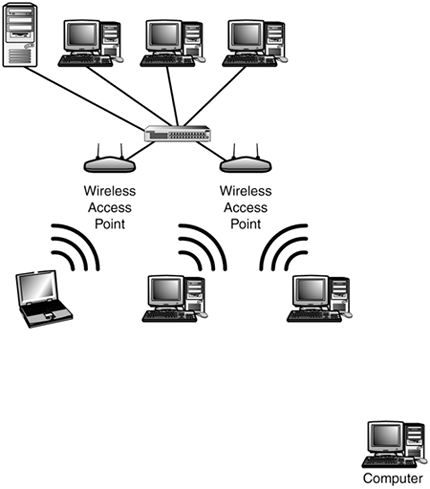| The American National Standards Institute (ANSI) developed the Fiber Distributed Data Interface (FDDI) standard in the mid-1980s to meet the growing need for a reliable and fast networking system to accommodate distributed applications. FDDI uses a ring network design, but, unlike the traditional 802.5 standard, FDDI uses a dual ring technology for fault tolerance. Because of the dual ring design, FDDI is not susceptible to a single cable failure like the regular 802.5 IEEE standard. Figure 1.8 shows an FDDI network with a dual ring configuration. Figure 1.8. FDDI network. 
As with any of the other standards, FDDI has specific characteristics: Speed FDDI transmits data at 100Mbps and higher. Topology FDDI uses a dual ring topology for fault-tolerant reasons. Media FDDI uses fiber-optic cable that enables data transmissions that exceed two kilometers. Additionally, it is possible to use FDDI protocols over copper wire known as the Copper Distributed Data Interface (CDDI). Access method Similar to 802.5, FDDI uses a token-passing access method.
Table 1.7 summarizes each of the wired standards discussed in the previous sections. Table 1.7. IEEE 802 Network StandardsStandard | Speed | Physical Topology | Logical Topology | Media | Access Method |
|---|
802.3 | 10Mbps | | Bus and Star | Coaxial and twisted pair | CSMA/CD | 802.3u | 100Mbps (Fast Ethernet) | Star | Bus | Twisted pair | CSMA/CD | 802.3z | 1000Mbps | Star | Bus | Twisted pair | CSMA/CD | 802.3ae | 10-Gigabit | | Backbone connections | N/A | Fiber/Not Required | 802.5 | 4Mbps and 16Mbps | Star | Ring | Twisted pair | Token passing | FDDI | 100Mbps | Dual ring | Ring | Fiber-optic Twisted pair (CDDI). | Token passing |
 | Pay close attention to the information provided in Table 1.7. You can expect questions on the Network+ exam based on the details provided in the table. |
802.11 IEEE Standards The 802.11 standards specify the characteristics of wireless LAN Ethernet networks. Under the banner of 802.11, there are four common wireless standards. These include 802.11, 802.11a, 802.11b and 802.11g. Each of these wireless standards identifies several characteristics. Here is a review of the 802.11 wireless standards and characteristics: Speed 802.11 standards are measured in Mbps and vary between network standards. Media The 802.11 standards use radio frequency (RF) as a transmission media. Depending on the standard, radio frequencies include 2.4GHz and 5GHz. Topology 802.11 wireless standards can be implemented in an ad-hoc or infrastructure topology. Access method 802.11 uses Carrier Sense Multiple Access/Collision Avoidance (CSMA/CA). CSMA/CA is a variation on the CSMA/CD access method. CSMA/CA access method uses a "listen before talking" strategy. Any system wanting to transmit data must first verify that the channel is clear before transmitting, thereby avoiding potential collisions. Spread Spectrum Spread spectrum refers to the manner in which data signals travel through a radio frequency. Spread spectrum requires that data signals either alternate between carrier frequencies or constantly change their data pattern. Spread spectrum is designed to trade off bandwidth efficiency for reliability, integrity, and security. Range 802.11 wireless standards each specify a transmission range. The range is influenced by many factors such as obstacles or weather.
The following is a look at the various 802.11 standards and their characteristics. IEEE 802.11 There were actually two variations on the initial 802.11 standard. Both offered 1 or 2Mbps transmission speeds and the same Radio Frequency (RF) of 2.4GHz. The difference between the two was in the way in which data traveled through the RF media. One used frequency hopping spread spectrum (FHSS), and the other, direct sequence spread spectrum (DSSS). IEEE 802.11a In terms of speed, the 802.11a standard was far ahead of the original standards. 802.11a specified speeds of up to 54Mbps in the 5GHz band; but most commonly, communications takes place at 6Mbps, 12Mbps, or 24Mbps. 802.11a is not compatible with other wireless standards 802.11b and 802.11g. These standards are heavily favored to the 802.11a standard. IEEE 802.11b The 802.11b standard provides for a maximum transmission speed of 11Mbps. However, devices are designed to be backward compatible with previous standards that provided for speeds of 1-, 2-, and 5.5Mbps. 802.11b uses a 2.4GHz RF range and is compatible with 802.11g. IEEE 802.11g 802.11g is a popular wireless standard today. 802.11g offers wireless transmission over distances of 150 feet and speeds up to 54Mbps compared with the 11 megabits per second of the 802.11b standard. Like 802.11b, 802.11g operates in the 2.4GHz range, and is thus compatible with it.
 | Each wireless standard has an associated speed. For instance, 802.11g lists a speed of up to 54Mbps. This number represents the pure data rate. However, in network data transmissions, many factors prevent the actual speeds from reaching this rate including data packet information, number of systems, and collisions on the network and interference. Once these are applied to the data rate, the actual speed is often less than half the data rate. Throughput represents the actual speed to expect from wireless transmissions. |
|
